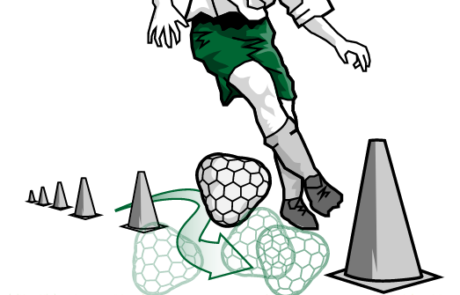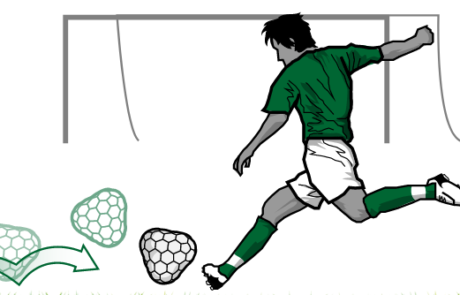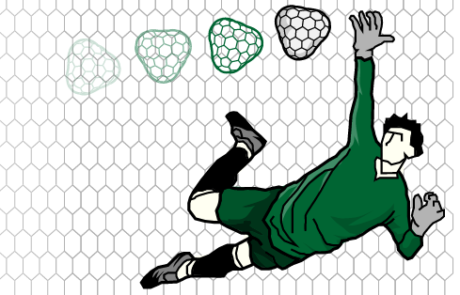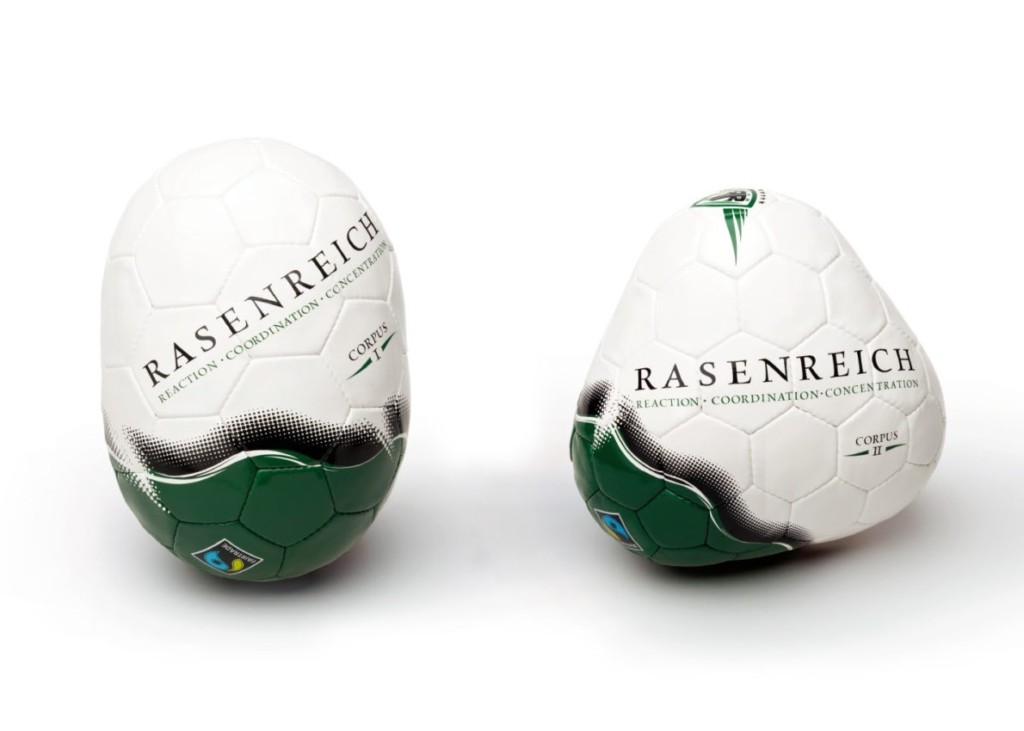
my role: object artist, business founder, managing partnerr 2010-2016
www.rasenreich.com
VFB versus BALL
(#1-62, 2001-2022)
VFB versus BALL describes the parts, or phases, of a process-oriented long-term project that aims to trigger thought processes on the topics of consumption, fashion, sports, and globalization.
“The point is the ball.”
(Dettmar Cramer, former coach of FC Bayern Munich)
The Ball Disturbance Association (German: Verein für Ballstörungen / VFB) offers humorous-ironic as well as serious opportunities to address the impact of Western lifestyles on the working conditions of people in soccer-producing countries. The top priorities were/are to generate new publics for the topic, and to try to continuously raise one’s own level of play.
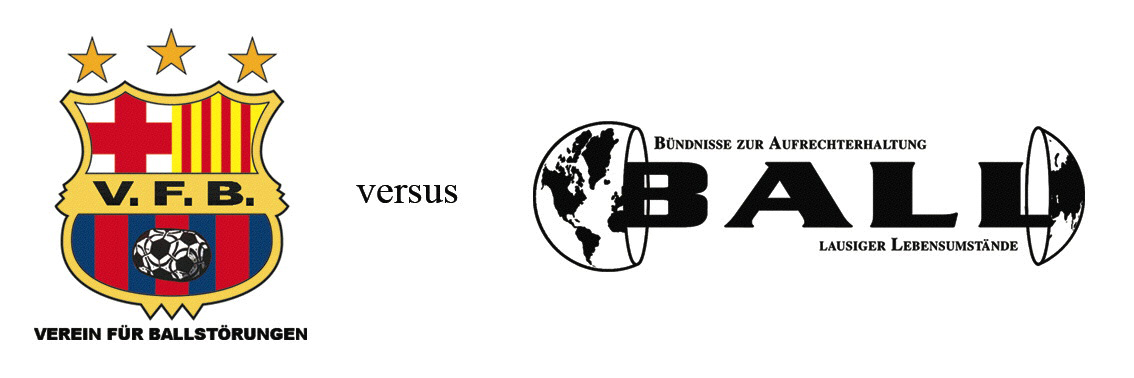
BALL (alliances to maintain lousy living conditions / German: Bündnisse zur Aufrechterhaltung lausiger Lebensumstände) is used in this match to summarize all those phenomena that generate or keep going socially and/or ecologically questionable aspects of the sporting goods industry. The VFB association operates at the intersection of the fields of soccer, visual arts, development policy, and product design, and focuses on the use of artistic power and creativity to transform segments of society.
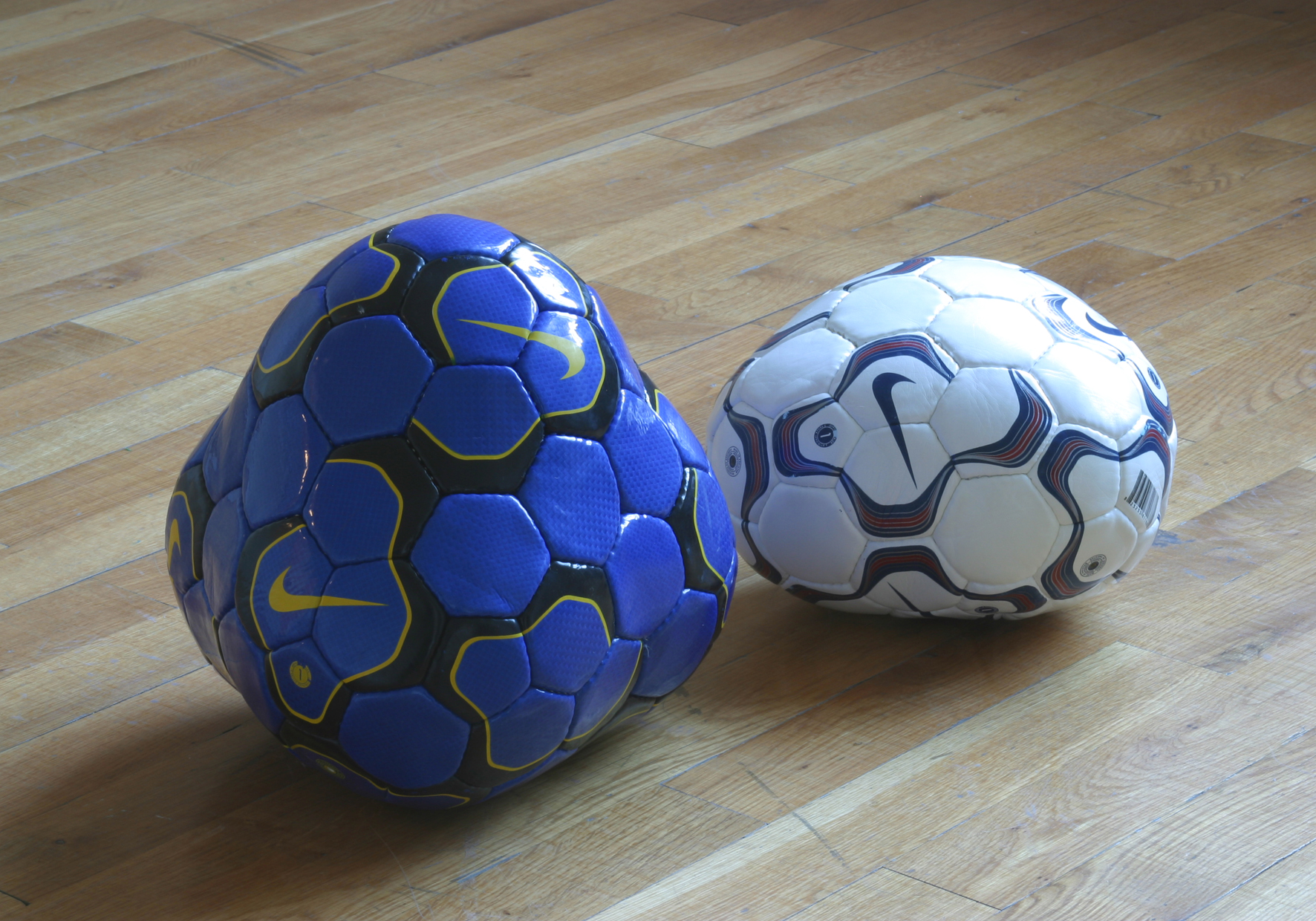
Object series made of branded footballs, 4 different shapes.
Installation view Galéria Jána Koniarka,
Trnava/SK (2003)
VFB versus BALL
#1: Global Player Matchballs (2001-2006)
One of the problem areas of globalized sporting goods production – extraordinarily poorly paid work, often performed by children under indisputable conditions – can be clearly seen in the example of soccer. An alternative to this are footballs from Fair Trade, which, despite good quality and low prices, are still largely unknown to the soccer public and not very widespread. The Global Player Matchballs series of objects (4 geometrically correct bodies in several color variations) is hand sewn using original tools. The material used was disassembled brand footballs, the individual parts of which were rearranged and sewn back together using standard commercial techniques. The deconstruction and reinterpretation of the central object in the sport of soccer is an attempt to question norms and break down patterns. Visual irritation and unpredictable rolling and jumping behavior generate heightened attention and concentration: something is wrong with the branded ball….
Since there is amazement and interest at every appearance in soccer circles, trial trainings could be carried out in different playing classes and different age groups from 2002 on. On the one hand, the players obviously had fun kicking, and on the other hand, I put forward the thesis: If you can handle these balls, you will no longer have a problem with the round ball. In 2004, the first training session took place with professional soccer players from the Austrian Top League (SV Austria Salzburg / today: Red Bull Salzburg), which also seemed interesting enough for the ORF sports editorial team to send a camera team. The resulting feature on the prime-time program “Sport am Sonntag” made it possible to reach a broad public for the first time. With the help of the soccer objects, it was possible to encounter an audience far removed from art – athletes as well as journalists – on a level that was familiar to them.
The Global Player Matchballs offer not only physical occasions for the examination of entrenched habits of perception and patterns of action. By answering questions that automatically arise, such as: “How do you make something like that?” or: “That’s insanely expensive – who actually does that?” it is often possible in conversations to casually begin a discussion about working conditions in production and the responsibility of consumers in this regard.
Finalist ISPO brandnew award 2010, Munich
(most important international sports fair)
VFB versus BALL
#62: TURF EMPIRE (2009-2024)
The art objects Global Player Matchballs were launched as serious soccer training equipment on the sporting goods market – with the intention of establishing FairTrade in sports.
A cooperation trio came together for this project: Sports kinesiologist Franz Mayer was able to provide expert evidence for the thesis formulated above, and graphic designer Bernd Wagner developed the CI and surface design. The company Rasenreich was born.
These sports equipment are bought neither as art objects, nor because of the FairTrade seal, but because of the actual training benefit – but in this way the products transport the FairTrade idea through the back door into the sporting goods industry and onto the training fields. Meanwhile, to teams from the highest divisions in various countries, including: Hertha BSC Berlin, FC Basel, Austria Wien, Zenith St. Petersburg, the U-21 teams of FC Bayern Munich and the Japanese national team, as well as to numerous youth performance centers of renowned professional teams throughout Europe.
The head is round so that thinking can change direction.
(Francis Picabia, 1922)

The ball is round so that the game can change direction.
(Book title on the subject of soccer tactics, 1999)
The mode of action: How CORPUS revolutionizes soccer training
Training with Rasenreich CORPUS improves coordination, technique and responsiveness. Field and goal players are challenged physically and mentally, which leads to an improvement in motor skills. Rasenreich CORPUS can be efficiently integrated into every form of play and practice in everyday training. One training device – hundreds of possible applications
The CORPUS I and II training devices provide a drastically increased level of difficulty. CORPUS is treated like a round soccer, but presents the players with unfamiliar situations, the mastery of which significantly improves ball handling skills, leading to decisive advantages in tournament play. Both designs develop the same effect, but have different playing characteristics. Switching between shapes is important to prevent habituation effects.
More details and training videos: www.rasenreich.com
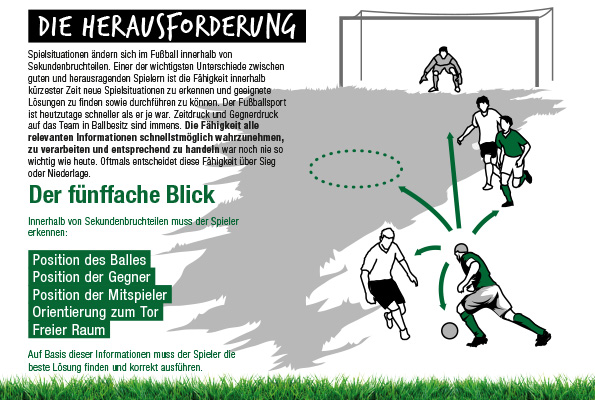
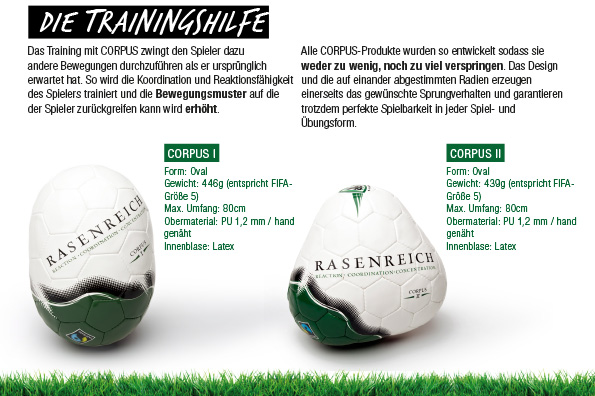
FOOTBALL & ART
In a society in which essential values such as acceleration and performance orientation can be read off from sports, a humorous act can succeed by handling icons of sport in such a way as to create fractures. I also understand such details as an introduction to my work for groups of people who otherwise have little or no contact with contemporary art. That helps to create the feeling of, “This guy, this artist, he’s kind of one of us, too.”
Most of my soccer work is explicitly aimed at reaching a soccer audience in untried ways, and then transporting information, criticism, etc… on a next level that otherwise would not have gotten past the defenses of the inner defense mechanisms. Ideally, this triggers reflection processes. I proceed according to a tactic that is only too well known: A striking, particularly beautiful or humorous event or appearance generates attention, which is then used for specific purposes.
In principle, most of my work would also work with another popular sport as a transport medium, because soccer is basically just the example I used to try to illuminate globalized production processes, for example. At the same time, however, the works work because of the wide distribution and intensity of the current cult of soccer. A circumstance that is also related to the immense increase in the media presence of soccer since the 1990s, and a potent player called the sporting goods industry.
Visible Nation and Contingency
Soccer is also significant “because national team games are one of the few moments when you can watch a nation made flesh” (see footnote 1). Here is the rare opportunity to “see” the country. The team is more alive than a flag and more tangible than GDP. For example, when Brazilian fans talk about the tactics they think the national team should implement, it’s not just a conversation about soccer. At the same time, it is also about how the country as a whole should behave, how to present and confront the world. Do you want a creative, dancing homeland, or one that is hardworking and functions like a well-oiled machine? The team is the nation.
One of the most cherished aspects of sporting events, contingency (2), is also largely responsible for my own soccer enthusiasm. If the favored team wins the game, it may well be that the spectator was offered an impressive “play” by their superior performance and the way they dominated the opponent. As mentioned, a fusion of authorship and performativity takes place. The standard expectation when watching a soccer match is to see beautiful moves, technical interludes at a high level, and artfully scored goals. All this, if you’re a fan, of course, of your own team. This claim is already not easy to fulfill, because “in a soccer match, everything is complicated by the presence of the opposing team.” (Jean-Paul Sartre)
A game like the one just described fulfills high expectations, but is fundamentally predictable. However, a sporting event is experienced far more intensively when something unforeseen happens, and soccer constantly produces situations where this can happen. Contingency means that each event generates the further course of the game. Maybe the player would score a goal if he crosses, but maybe it is better he decides to dribble. Or even more simply: It can be decisive for the game whether the goalkeeper hits the ball into the left or the right half of the pitch during the goal kick, simply because there are different people on the left and the right side of the pitch. Successful action and failure are extremely close, especially in soccer, both in terms of the game as a whole and in terms of individual actions. The timing of a pass, the exact angle of the foot when taking a shot on goal, the intuitive reaction of the goalkeeper – each of these moments can completely change the course of the rest of the game, and the players must constantly react to these changes. Contingency is constantly at play, and is felt most strongly when everything is on the line. It is in these moments that soccer is most fascinating.
Such situations are deliberately created in soccer by certain rules of the game, for example when a decision on victory or defeat has to be brought about from the outside. For example, the away goals rule (3) in the UEFA Cup or the penalty shootout in a tournament like the World Cups. A penalty shootout takes the drama to the extreme. The last penalty, as a brief moment, decides victory or defeat after 120 minutes of play. Thus, apart from the players, the elusive concept of contingency would also be responsible for defining soccer as art.
Footnotes
1 John Gill, introduction to the exhibition catalog “Offside! Contemporary artists and football”, Manchester City Art Gallery, 1996
2 Wolfgang Welsch, Sport: Aesthetically Considered – and Even as Art?, in: Art and Sport I, Kunstforum 169, 2004.
3 Explanation of this rule: When two teams meet in the knockout phase of the UEFA Cup, and determine the advancement to the next round in one home and one away match each, the so-called “away goals rule” is often applied. The winner is usually determined by adding both results. For example, if the score is 1:0 in the first match, and 0:2 in the second match, the total score is 1:2 , and club B advances. If the goals scored in both matches are equal (e.g. 1:0 in the first match, and 1:2 in the second match – result 2:2 in total), this rule states that the team that has scored more goals away from home, i.e. in the opponent’s stadium, advances to the next round. The away goals rule creates match situations where, for example, a team that would be eliminated at the current score can still manage to win overall with just one extra goal. It is not necessary to score an equalizing goal first and then another winning goal, such as in a one-on-one match.
